Nutrient and Stoichiometric Characteristics of Aggregates in a Sloping Farmland Area under Different Tillage Practices
Abstract
:1. Introduction
2. Materials and Methods
2.1. Study Area
2.2. Experimental Plot Design
2.3. Soil Sample Treatment and Determination Methods
2.4. Data Processing Methods
3. Results
3.1. Aggregate Particle-Size Proportions in the Tillage Plots
3.1.1. Dry-Sieved Aggregates
3.1.2. Wet-Sieved Aggregates
3.2. Soil and Aggregate Nutrient Contents under Tillage Measures
3.2.1. Soil Nutrient Content
3.2.2. Aggregate Nutrient Content
3.3. Soil Stoichiometric Ratios under Different Tillage Measures
3.3.1. Soil Stoichiometric Ratios
3.3.2. Aggregate Stoichiometric Ratios
4. Discussion
4.1. Effects of Long-Term Tillage Practices on Soil Aggregates
4.2. Effects of Long-Term Tillage Measures on Soil Nutrients
4.3. Effects of Long-Term Tillage Measures on Soil Stoichiometric Ratios
4.4. Comprehensive Analysis of the Influence of Various Factors on Soil Nutrients and Stoichiometric Ratios in Sloping Farmland
5. Conclusions
Author Contributions
Funding
Institutional Review Board Statement
Informed Consent Statement
Data Availability Statement
Acknowledgments
Conflicts of Interest
References
- Ma, W.M.; Li, Z.W.; Ding, K.Y.; Huang, J.Q.; Nie, X.D.; Zeng, G.M.; Wang, S.G.; Liu, G. Effect of soil erosion on dissolved organic carbon redistribution in subtropical red soil under rainfall simulation. Geomorphology 2014, 226, 217–225. [Google Scholar] [CrossRef]
- Zhao, Q.G.; Huang, G.Q.; Ma, Y.Q. The problems in red soil ecosystem in southern of China and its countermeasures. Acta Ecol. Sin. 2013, 33, 7615–7622. [Google Scholar]
- Wang, W.Q.; Wang, C.; Sardans, J.; Min, Q.W.; Zeng, C.S.; Tong, C.; Peñuelas, J. Agricultural land use decouples soil nutrient cycles in a subtropical riparian wetland in China. Catena 2013, 133, 171–178. [Google Scholar] [CrossRef]
- Li, Z.P.; Han, C.W.; Han, F.X. Organic C and N mineralization as affected by dissolved organic matter in paddy soils of subtropical China. Geoderma 2010, 157, 206–213. [Google Scholar] [CrossRef]
- Chalise, D.; Kumar, L.; Kristiansen, P. Land degradation by soil erosion in Nepal: A review. Soil Syst. 2019, 3, 12. [Google Scholar] [CrossRef] [Green Version]
- Bronick, C.J.; Lal, R. Soil structure and management: A review. Geoderma 2005, 124, 3–22. [Google Scholar] [CrossRef]
- Zhang, B.; XU, Y.Z.; Li, N.; Qiao, Y.F.; Jiang, H.; Han, X.Z. Recent development in controlling factors for aggregated soil structure. Soil Crop 2014, 3, 41–49. [Google Scholar]
- Li, D.J.; Wen, L.; Yang, L.Q.; Luo, P.; Xiao, K.C.; Chen, H.; Zhang, W.; He, X.Y.; Chen, H.S.; Wang, K. Dynamics of soil organic carbon and nitrogen following agricultural abandonment in a karst region. J. Geophys. Res. Biogeosci. 2017, 122, 230–242. [Google Scholar] [CrossRef]
- Wang, C.; Xiong, F.; Lu, Y.; Li, B.; Tang, X.; Dong, Y.Q. Effect of land use on topsoil aggregate distribution and stoichiometric characteristics of C, N, and P in the Pearl River Delta. J. Agric. Resour. Environ. 2021, in press. [Google Scholar] [CrossRef]
- Wang, M.; Chen, H.; Zhang, W.; Wang, K. Soil nutrients and stoichiometric ratios as affected by land use and lithology at county scale in a karst area, southwest China. Sci. Total Environ. 2018, 619, 1299–1307. [Google Scholar] [CrossRef]
- Bradshaw, C.; Kautsky, U.; Kumblad, L. Ecological stoichiometry and multi-element transfer in a coastal ecosystem. Ecosystems 2012, 15, 591–603. [Google Scholar] [CrossRef] [Green Version]
- Guo, X.; Jiang, Y.F. Spatial characteristics of ecological stoichiometry and their driving factors in farmland soils in Poyang Lake Plain, Southeast China. J. Soils Sediments 2019, 19, 263–274. [Google Scholar] [CrossRef]
- Elser, J.J.; Fagan, W.F.; Denno, R.F.; Dobberfuhl, D.R.; Folarin, A.; Huberty, A.; Interlandi, S.; Kilham, S.S.; McCauley, E.; Schulz, K.L.; et al. Nutritional constraints in terrestrial and freshwater food webs. Nature 2000, 408, 578–580. [Google Scholar] [CrossRef] [PubMed]
- Hill, B.H.; Elonen, C.M.; Seifert, L.R.; May, A.A.; Tarquinio, E. Microbial enzyme stoichiometry and nutrient limitation in US streams and rivers. Ecol. Indic. 2012, 18, 540–551. [Google Scholar] [CrossRef]
- Niu, S.Q.; Ren, L.N.; Song, L.J.; Duan, Y.Y.; Huang, T.; Han, X.H.; Hao, W.F. Plant stoichiometry characteristics and relationships with soil nutrients in Robinia pseudoacacia communities of different planting ages. Acta Ecol. Sin. 2017, 37, 355–362. [Google Scholar] [CrossRef]
- Yang, Y.; Liu, B.R.; An, S.S. Ecological stoichiometry in leaves, roots, litters and soil among different plant communities in a desertified region of Northern China. Catena 2018, 166, 328–338. [Google Scholar] [CrossRef]
- Elser, J.J.; Fagan, W.F.; Kerkhoff, A.J.; Swenson, N.G.; Enquist, B.J. Biological stoichiometry of plant production: Metabolism, scaling and ecological response to global change. New Phytol. 2010, 186, 593–608. [Google Scholar] [CrossRef] [Green Version]
- Deng, L.; Wang, K.B.; Chen, M.L.; Shangguan, Z.P.; Sweeney, S. Soil organic carbon storage capacity positively related to forest succession on the Loess Plateau, China. Catena 2013, 110, 1–7. [Google Scholar] [CrossRef]
- Bing, H.J.; Wu, Y.H.; Zhou, J.; Sun, H.Y.; Luo, J.; Wang, J.P.; Yu, D. Stoichiometric variation of carbon, nitrogen, and phosphorus in soils and its implication for nutrient limitation in alpine ecosystem of Eastern Tibetan Plateau. J. Soils Sediments 2016, 16, 405–416. [Google Scholar] [CrossRef]
- Xu, C.H.; Xiang, W.H.; Gou, M.M.; Chen, L.; Lei, P.F.; Fang, X.; Deng, X.W.; Ouyang, S. Effects of forest restoration on soil carbon, nitrogen, phosphorus, and their stoichiometry in Hunan, southern China. Sustainability 2018, 10, 1874. [Google Scholar] [CrossRef] [Green Version]
- Wu, T.G.; Chen, B.F.; Xiao, Y.H.; Pan, Y.J.; Chen, Y.; Xiao, J.H. Leaf stoichiometry of trees in three forest types in Pearl River Delta, South China. J. Plant Ecol. 2010, 34, 58–63. [Google Scholar]
- Pan, F.J.; Zhang, W.; Wang, K.L.; He, X.Y.; Liang, S.C.; Wei, G.F. Litter C:N:P ecological stoichiometry character of plant communities in typical Karst Peak-Cluster Depression. Acta Ecol. Sin. 2011, 31, 335–343. [Google Scholar]
- Gao, Y.; He, N.P.; Yu, G.R.; Chen, W.L.; Wang, Q.F. Long-term effects of different land use types on C, N, and P stoichiometry and storage in subtropical ecosystems: A case study in China. Ecol. Eng. 2014, 67, 171–181. [Google Scholar] [CrossRef]
- An, W.L.; Xie, H.Y.; Wang, W.Q.; Zeng, C.S. Effects of straw returning on nutrient content and ecological stoichiometric ratio of soil water-stable aggregates in paddy field. Chin. J. Ecol. 2017, 36, 150. [Google Scholar]
- Liu, X.; Ma, J.; Ma, Z.W.; Li, L.H. Soil nutrient contents and stoichiometry as affected by land-use in an agro-pastoral region of northwest China. Catena 2017, 150, 146–153. [Google Scholar] [CrossRef]
- Du, L.; Zhang, X.Z.; Zheng, Z.C.; Li, T.X.; Wang, Y.D.; Huang, H.G.; Yu, H.Y.; Ye, D.H.; Liu, T. Paddy soil nutrients and stoichiometric ratios as affected by anthropogenic activities during long-term tillage process in Chengdu Plain. J. Soils Sediments 2020, 20, 3835–3845. [Google Scholar] [CrossRef]
- Du, Y.N.; Li, T.Y.; He, B.H.; He, X.R.; Fu, S. Stoichiometric Characteristics of Purple Sloping Cropland Under Long-term Fertilization and Cultivation. Environ. Sci. 2020, 41, 394–402. [Google Scholar]
- Zeng, Q.C.; Li, X.; Dong, Y.H.; An, S.S.; Darboux, F. Soil and plant components ecological stoichiometry in four steppe communities in the Loess Plateau of China. Catena 2016, 14, 481–488. [Google Scholar] [CrossRef]
- Piaszczyk, W.; Błońska, E.; Lasota, J.; Lukac, M. A comparison of C:N:P stoichiometry in soil and deadwood at an advanced decomposition stage. Catena 2019, 179, 1–5. [Google Scholar] [CrossRef]
- Lu, R.K. Methods of Soil Agricultural Chemical Analysis; China Agricultural Science and Technology Press: Beijing, China, 1999; pp. 107, 128, 135. [Google Scholar]
- Ministry of Agriculture, PRC. Soil Testing—Part 19: Method for Determination of Soil Water Stable Macro-Aggregates Distribution; China Agricultural Press: Beijing, China, 2008; pp. 1–3.
- Puget, P.; Chenu, C.; Balesdent, J. Dynamics of soil organic matter associated with particle-size fractions of water-stable aggregates. Eur. J. Soil Sci. 2000, 51, 595–605. [Google Scholar] [CrossRef]
- Six, J.; Elliott, E.T.; Paustian, K. Aggregate and soil organic matter dynamics under conventional and no-tillage systems. Soil Sci. Soc. Am. J. 1999, 63, 1350–1358. [Google Scholar] [CrossRef] [Green Version]
- He, S.L.; Huang, S.S.; Zhong, Y.J.; Huang, Q.R.; Cheng, Y.H.; Zhang, K.; Wu, L.; Li, X.F.; Ye, C. Effects of tillage depth on the characteristics of soil water-stability aggregates in sloping farmland of red soil. Res. Soil Water Conserv. 2019, 26, 127–132. [Google Scholar]
- Cheng, Y.H.; Wu, L.; Sun, H.J.; Zhong, Y.J.; Sun, Y.M.; Zhang, X.L.; Huang, S.S.; Huang, Q.R. Effects of straw mulching and Vetiver grass hedgerows on the size distribution of the soil water stable aggregates and aggregate-associated organic carbon in red soil. Acta Ecol. Sin. 2016, 36, 3518–3524. [Google Scholar]
- Zechmeister-Boltenstern, S.; Keiblinger, K.M.; Mooshammer, M.; Peñuelas, J.; Richter, A.; Sardans, J.; Wanek, W. The application of ecological stoichiometry to plant–microbial–soil organic matter transformations. Ecol. Monogr. 2015, 85, 133–155. [Google Scholar] [CrossRef] [Green Version]
- Zhao, S.W.; Su, J.; Wu, J.S.; Yang, Y.H.; Liu, N.N. Changes of Soil Aggregate Organic Carbon During Process of Vegetation Restoration in Ziwuling. J. Soil Water Conserv. 2006, 3, 114–117. [Google Scholar]
- Martínez, E.; Fuentes, J.P.; Pino, V.; Silva, P.; Acevedo, E. Chemical and biological properties as affected by no-tillage and conventional tillage systems in an irrigated Haploxeroll of Central Chile. Soil Tillage Res. 2013, 126, 238–245. [Google Scholar] [CrossRef]
- Gao, Y.; Yu, G.R.; Luo, C.Y.; Zhou, P. Groundwater nitrogen pollution and assessment of its health risks: A case study of a typical village in rural-urban continuum, China. PLoS ONE 2012, 7, e33982. [Google Scholar] [CrossRef] [Green Version]
- Jiang, Y.F.; Ye, Y.C.; Guo, X.; Rao, L.; Li, W.F.; Sun, K. Spatial distribution of soil available phosphorus and its driving factors under different erosion degrees in South China. Soils 2018, 50, 1013–1021. [Google Scholar]
- Zhang, Y.; Li, P.; Liu, X.J.; Xiao, L.; Shi, P.; Zhao, B.H. Effects of farmland conversion on the stoichiometry of carbon, nitrogen, and phosphorus in soil aggregates on the Loess Plateau of China. Geoderma 2019, 351, 188–196. [Google Scholar] [CrossRef]
- Pu, Y.L.; Xie, D.T.; Lin, C.W.; Wei, C.F. Characteristics of soil comprehensive anti-erodibility under sloped cropland with hedgerows. Trans. Chin. Soc. Agric. Eng. 2013, 29, 125–135. [Google Scholar]
- Gao, H.Y.; Guo, S.L.; Liu, W.Z.; Che, S.G.; Li, M. Effect of fertilization on organic carbon distribution in various fractions of aggregates in caliche soils. Acta Pedol. Sin. 2010, 47, 931–938. [Google Scholar]
- Wright, A.L.; Hons, F.M. Carbon and nitrogen sequestration and soil aggregation under sorghum cropping sequences. Biol. Fertil. Soils 2005, 41, 95–100. [Google Scholar] [CrossRef]
- Kan, Z.R.; Ma, S.T.; Liu, Q.Y.; Liu, B.Y.; Virk, A.L.; Qi, J.Y.; Zhao, X.; Lal, R.; Zhang, H.L. Carbon sequestration and mineralization in soil aggregates under long-term conservation tillage in the North China Plain. Catena 2020, 188, 104428. [Google Scholar] [CrossRef]
- Wang, S.Q.; Yu, G.R. Ecological stoichiometry characteristics of ecosystem carbon, nitrogen and phosphorus elements. Acta Ecol. Sin. 2008, 28, 3937–3947. [Google Scholar]
- Cleveland, C.C.; Liptzin, D. C:N:P stoichiometry in soil: Is there a “Redfield ratio” for the microbial biomass? Biogeochemistry 2007, 85, 235–252. [Google Scholar] [CrossRef]
- Tian, H.Q.; Chen, G.S.; Zhang, C.; Melillo, J.M.; Hall, C.A.S. Pattern and variation of C:N:P ratios in China’s soils: A synthesis of observational data. Biogeochemistry 2010, 98, 139–151. [Google Scholar] [CrossRef]
- Cheng, H.; Gong, Y.B.; Wu, Q.; Li, Y.; Liu, Y.; Zhu, D.W. Content and ecological stoichiometry characteristics of organic carbon, nitrogen and phosphorus of typical soils in sub-alpine/alpine mountain of Western Sichuan. J. Nat. Resour. 2018, 33, 161–172. [Google Scholar]
- Batjes, N.H. Total carbon and nitrogen in the soils of the world. Eur. J. Soil Sci. 1996, 47, 151–163. [Google Scholar] [CrossRef]
- Spaccini, R.; Piccolo, A.; Haberhauer, G.; Stemmer, M.; Gerzabek, M.H. Decomposition of maize straw in three European soils as revealed by DRIFT spectra of soil particle fractions. Geoderma 2001, 99, 245–260. [Google Scholar] [CrossRef]

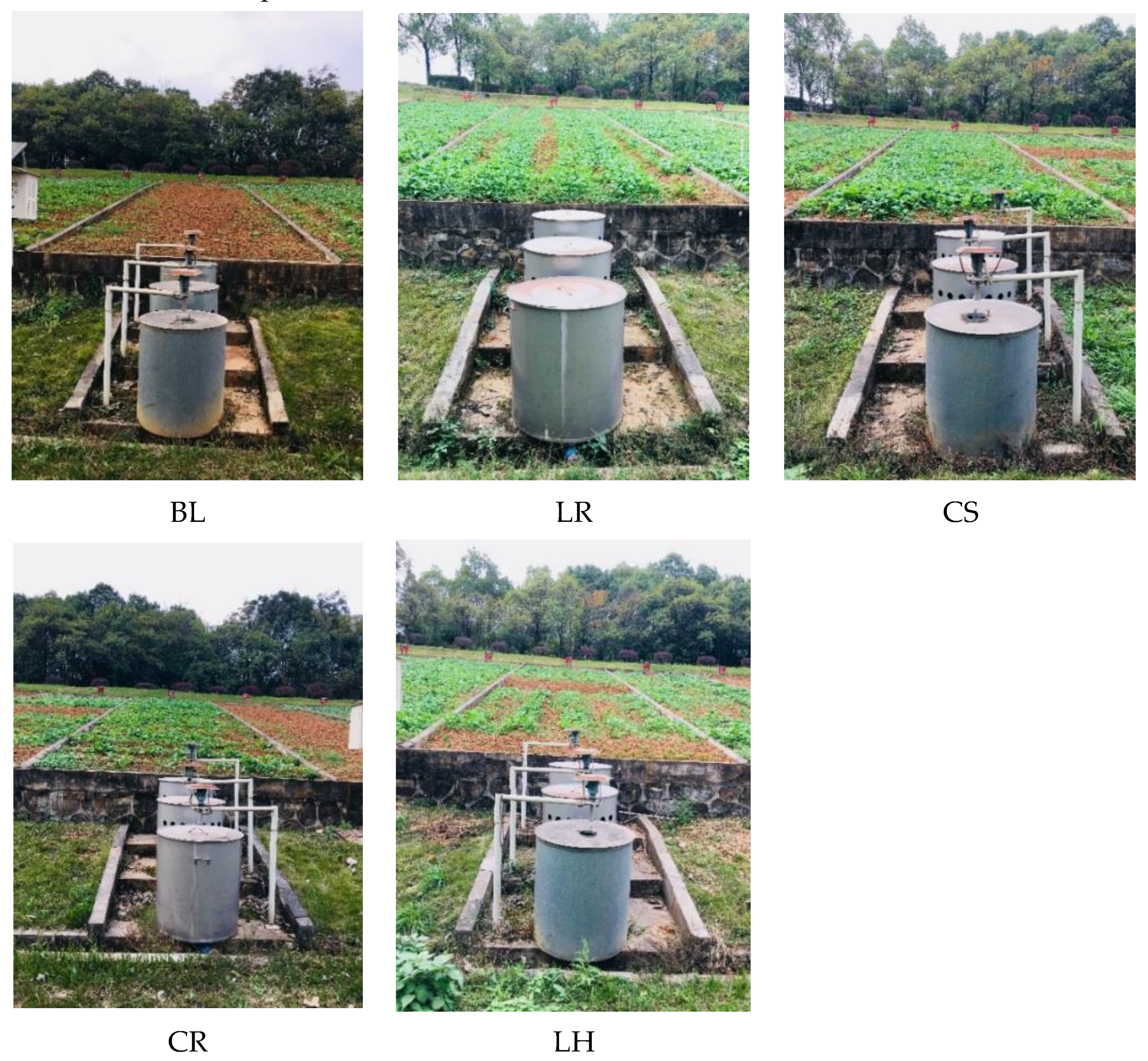
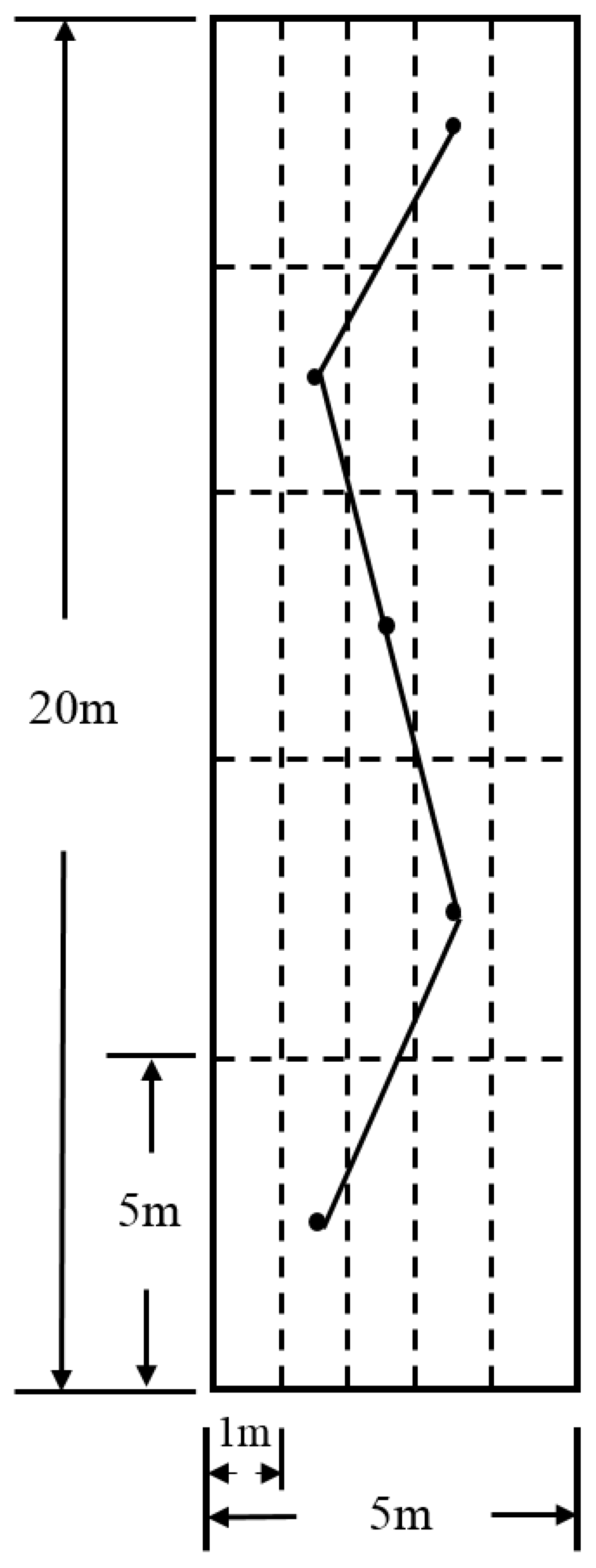
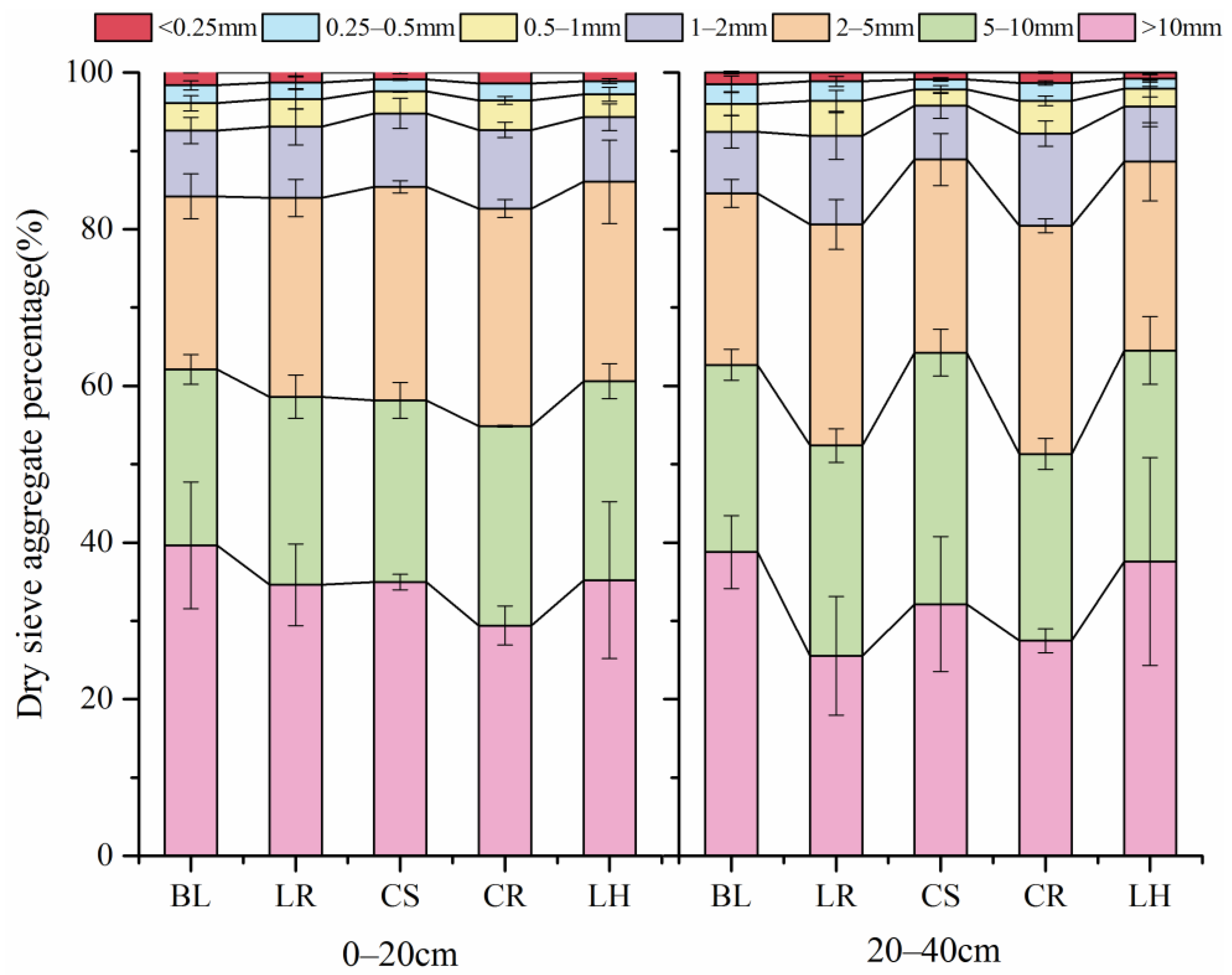
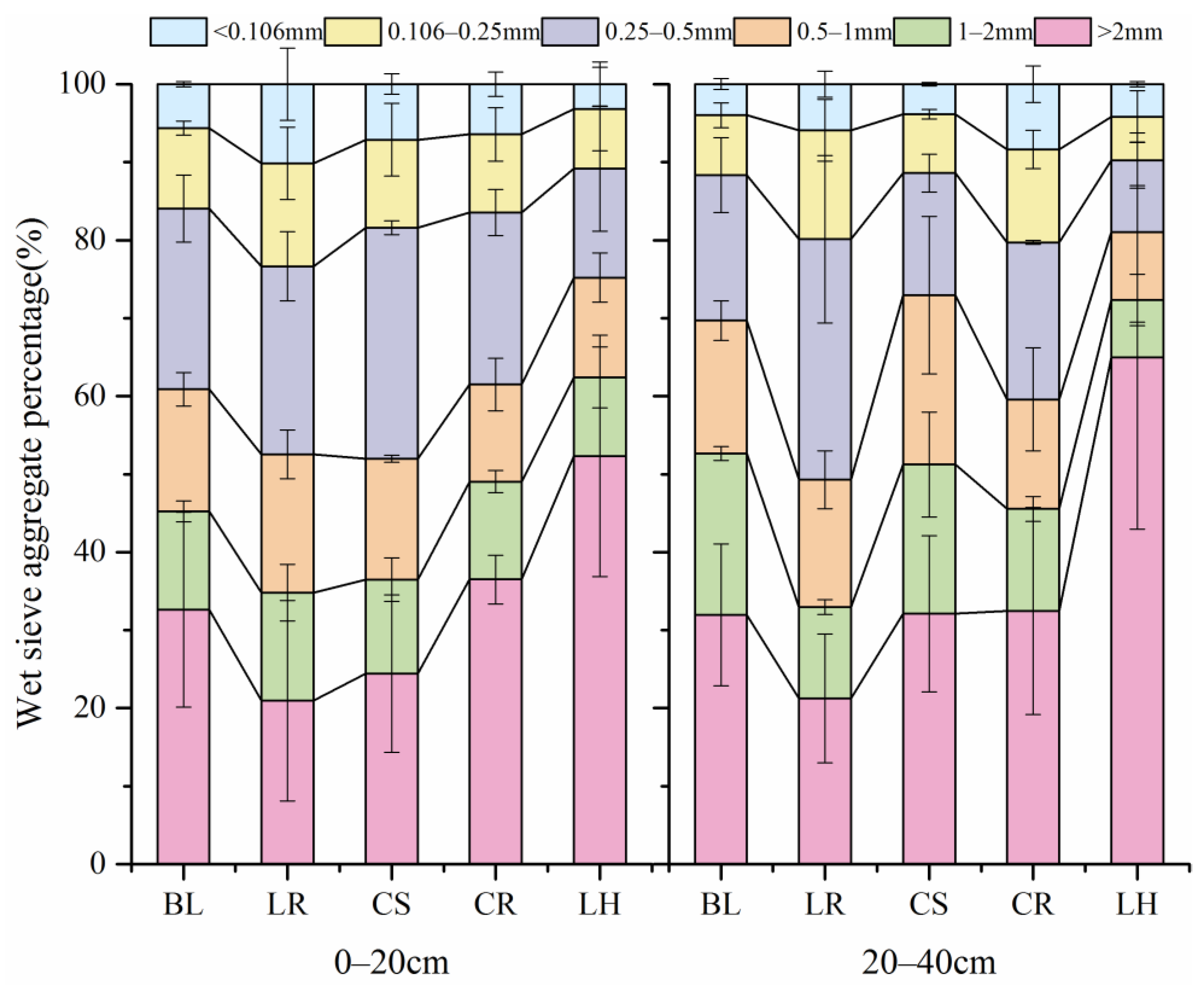

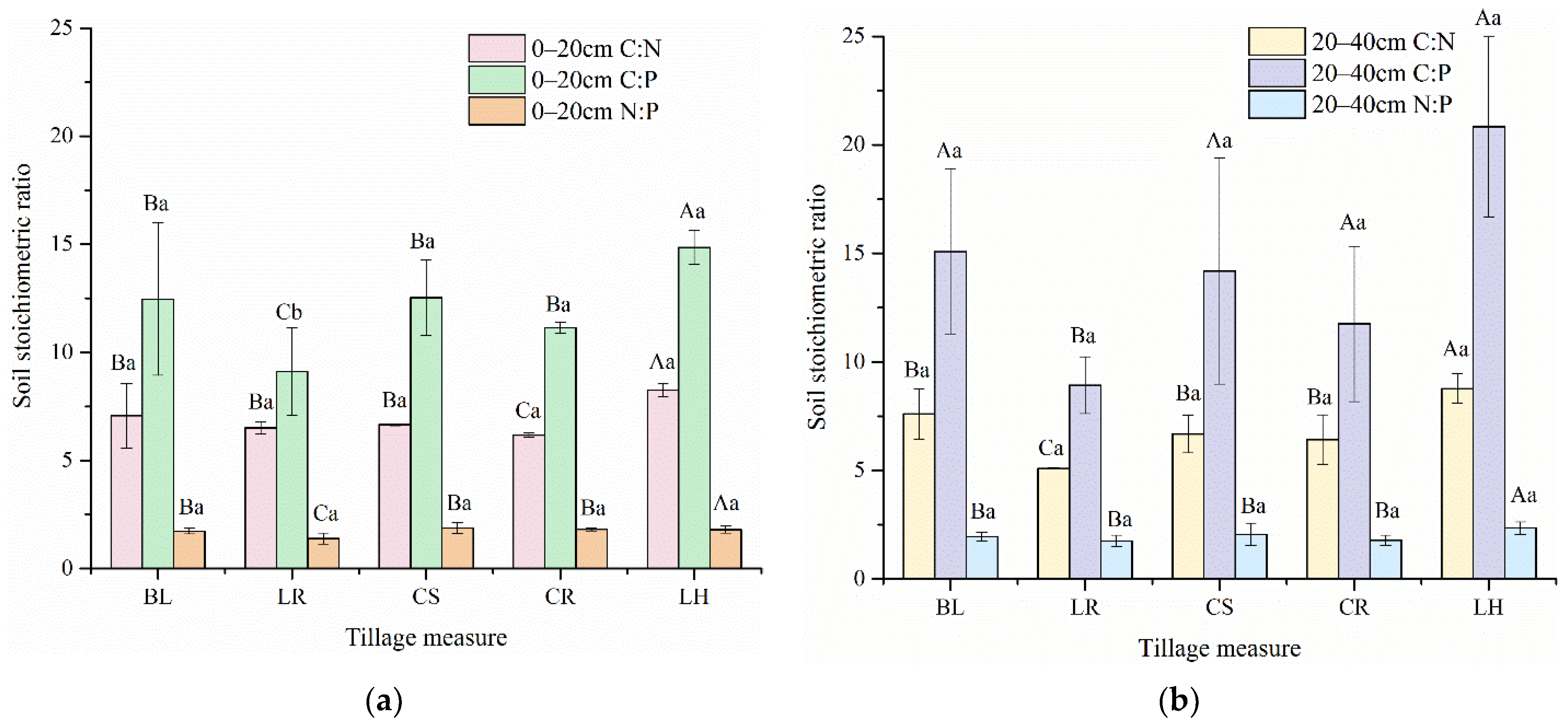
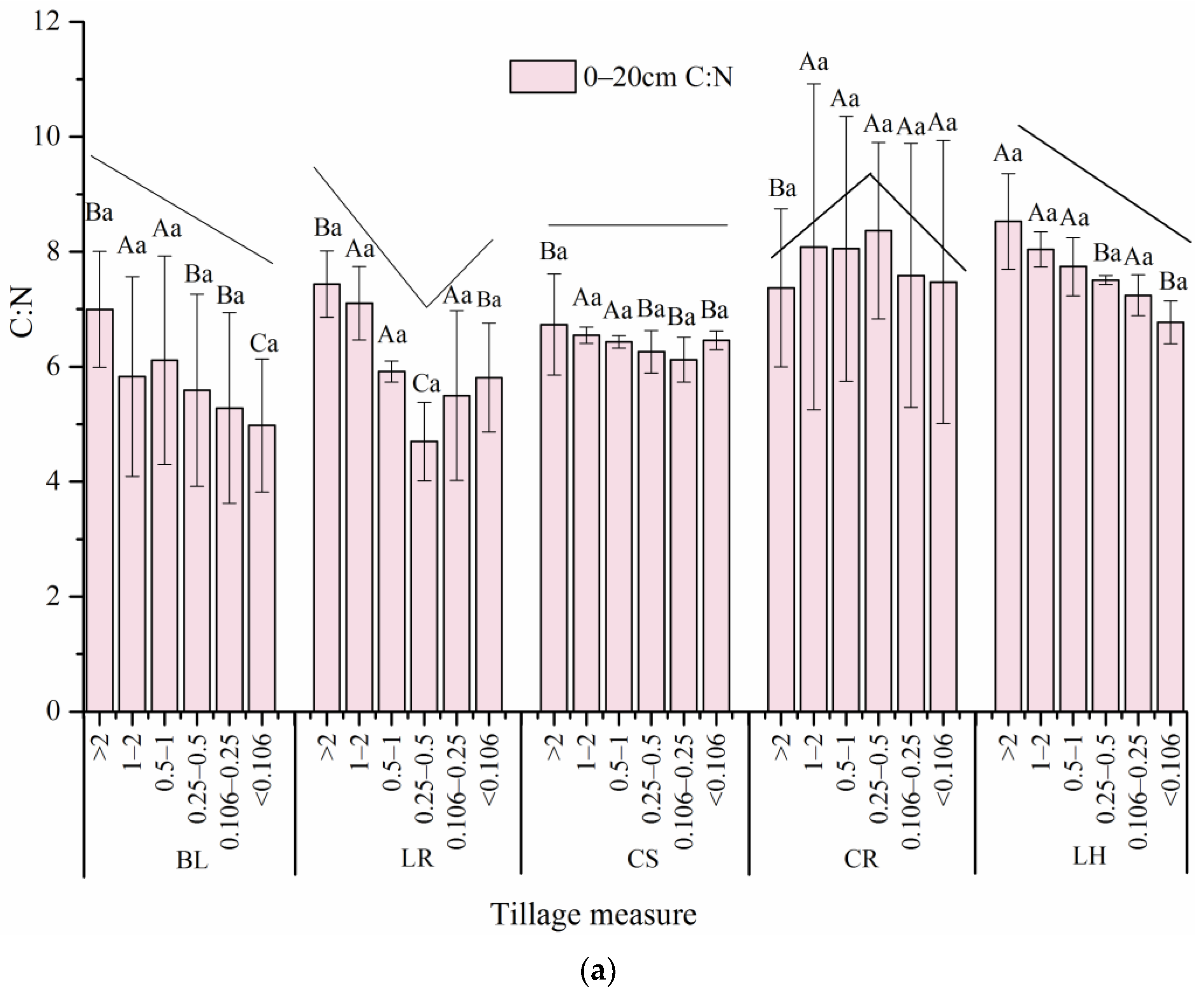
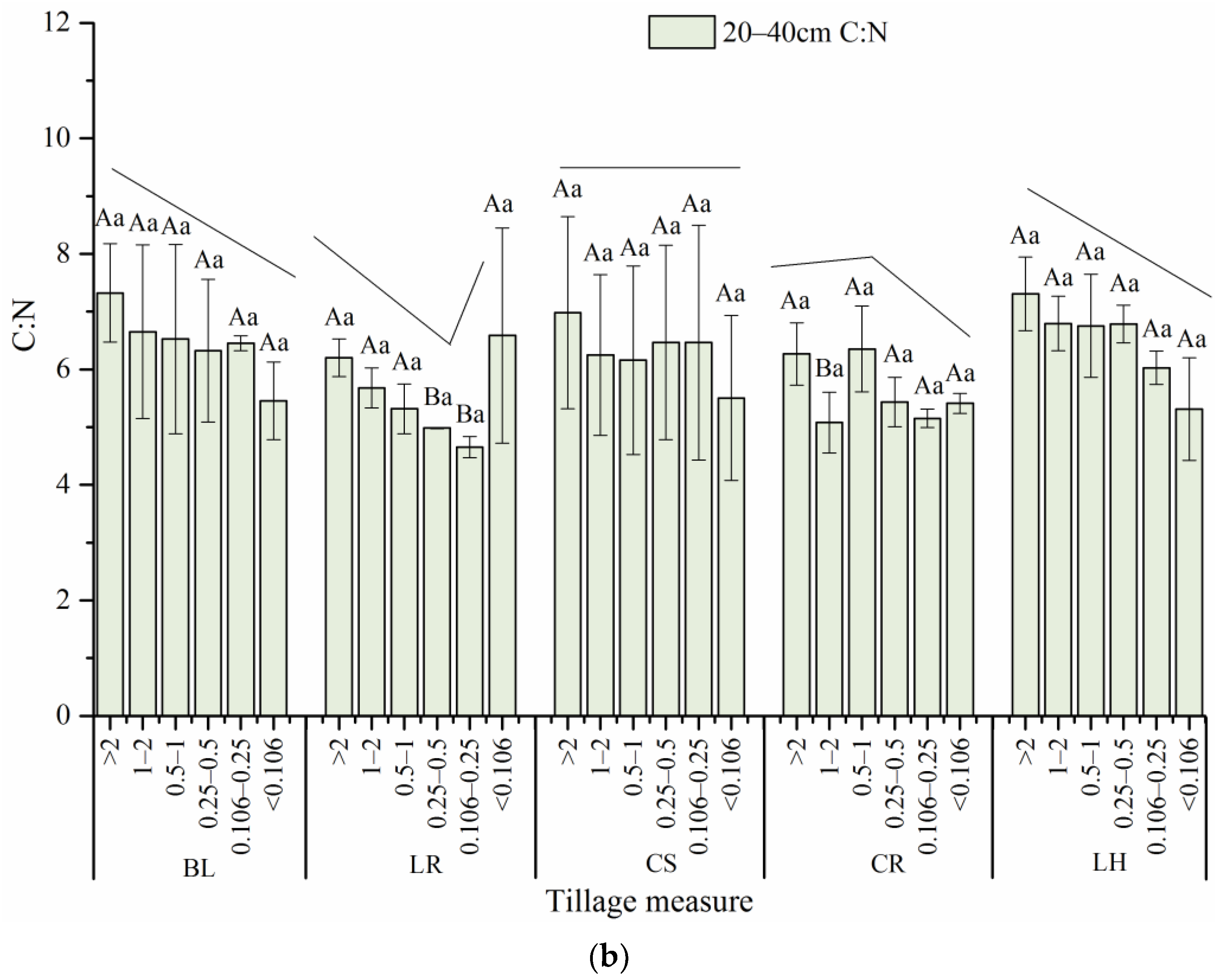
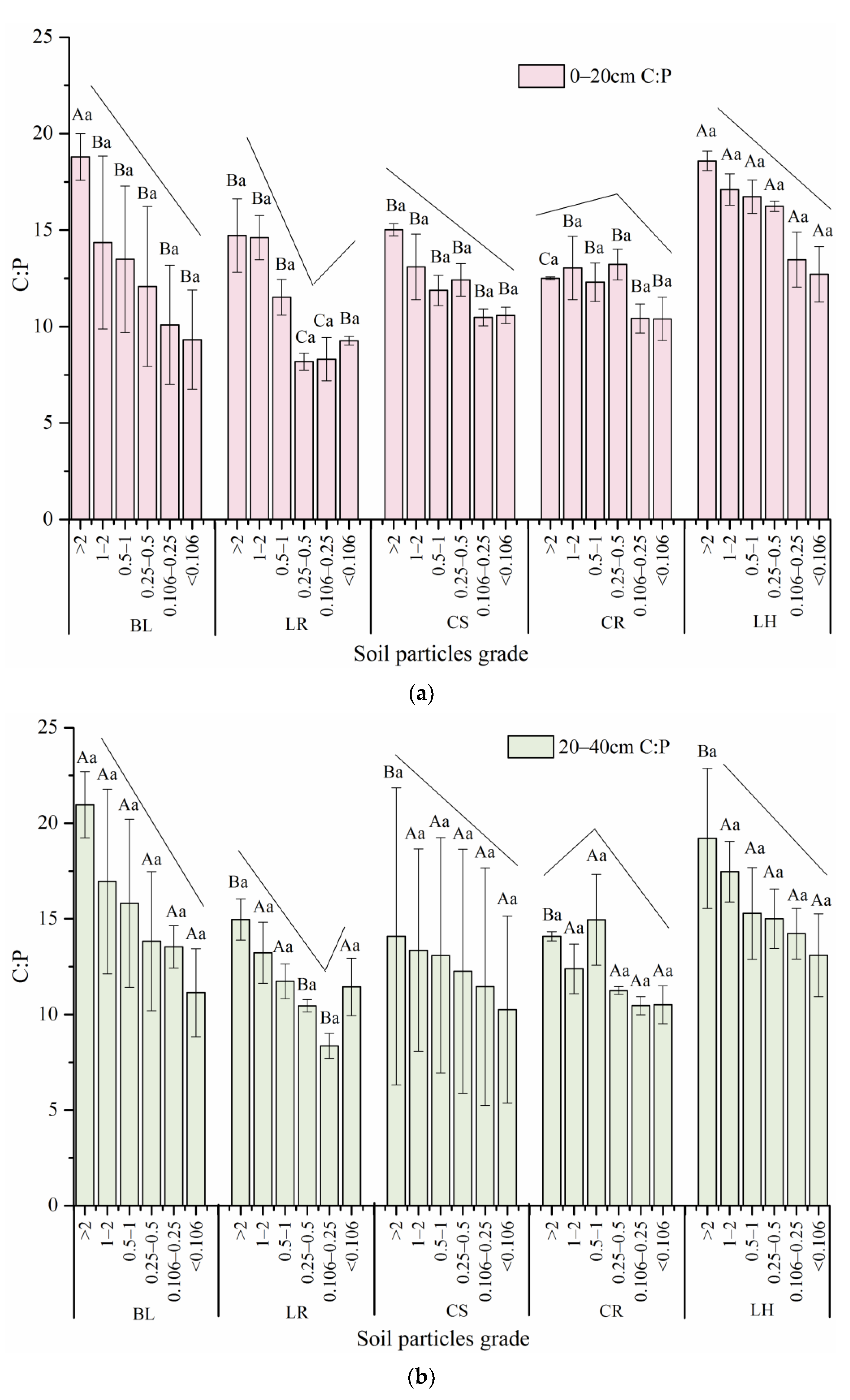
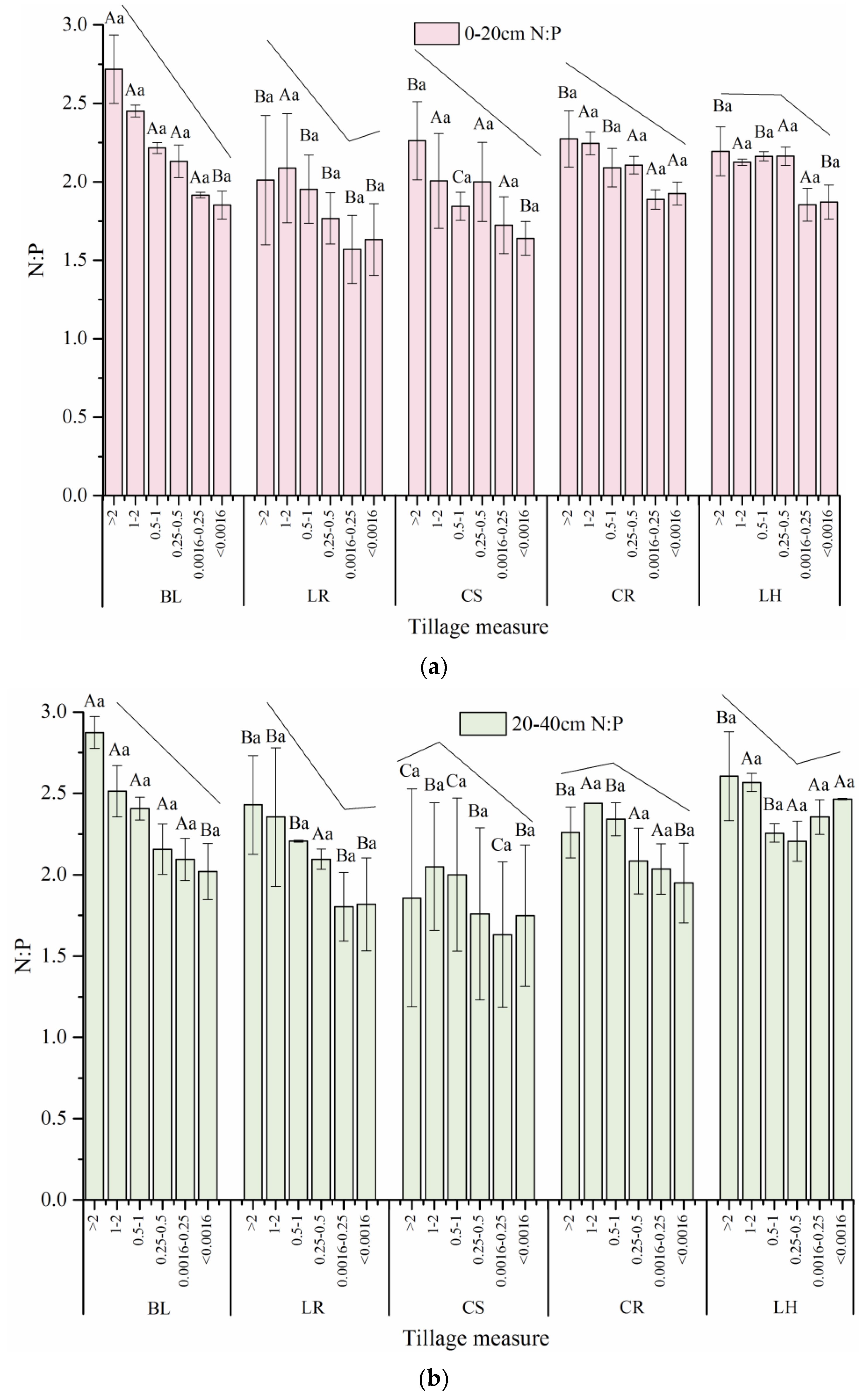
| SOC (g.kg−1) | TN (g.kg−1) | TP (g.kg−1) | TK (g.kg−1) | pH | Sand (0.05–2 mm) | Silt (0.002–0.05 mm) | Clay (<0.002 mm) |
|---|---|---|---|---|---|---|---|
| 8.64 | 0.55 | 0.31 | 15.87 | 6.73 | 29.68% | 45.56% | 24.76% |
| Tillage Measure | Slope | Plot Size | Replicates | Treatment Details |
|---|---|---|---|---|
| Bare land (BL) | 10° | 5 × 20 m | 2 | Pure soil that nothing grows, Plowed and fertilized in the same way as the other plots. |
| Longitudinal-ridge tillage (LR) | 10° | 5 × 20 m | 2 | Ridges (70 cm wide) and furrows (30 cm wide). |
| Conventional tillage + straw mulching (CS) | 10° | 5 × 20 m | 2 | Flat-plowed without ridging and covered with straw (1 kg/m2). |
| Cross-ridge tillage (CR) | 10° | 5 × 20 m | 2 | Ridges (70 cm wide) and furrows (30 cm wide). |
| Longitudinal-ridge tillage + hedgerows (LH) | 10° | 5 × 20 m | 2 | Ridges (70 cm wide) and furrows (30 cm wide). Two daylily hedgerows (50 cm wide) were planted at the bottom and 10 m from the bottom the plot. |
| Aggregates of Different Grain Sizes | 0–20 cm | 20–40 cm | ||||||||
|---|---|---|---|---|---|---|---|---|---|---|
| BL | LR | CS | CR | LH | BL | LR | CS | CR | LH | |
| >2 | 5.16 ± 0.20 | 6.57 ± 0.16 | 4.90 ± 0.07 | 3.86 ± 0.00 | 7.61 ± 0.15 | 5.40 ± 0.18 | 4.67 ± 0.15 | 5.08 ± 0.27 | 4.15 ± 0.11 | 5.22 ± 0.18 |
| 2–1 | 4.24 ± 0.30 | 5.01 ± 0.11 | 4.23 ± 0.04 | 3.98 ± 0.08 | 6.33 ± 0.04 | 4.60 ± 0.27 | 3.41 ± 0.02 | 4.13 ± 0.29 | 3.35 ± 0.07 | 4.87 ± 0.07 |
| 0.5–1 | 4.15 ± 0.28 | 3.91 ± 0.07 | 3.68 ± 0.06 | 3.86 ± 0.03 | 5.96 ± 0.03 | 4.41 ± 0.27 | 3.11 ± 0.05 | 3.88 ± 0.27 | 3.90 ± 0.08 | 4.45 ± 0.12 |
| 0.25–0.5 | 3.73 ± 0.27 | 2.99 ± 0.11 | 3.68 ± 0.06 | 3.86 ± 0.06 | 5.38 ± 0.10 | 3.99 ± 0.23 | 2.77 ± 0.00 | 3.88 ± 0.27 | 3.18 ± 0.04 | 4.17 ± 0.07 |
| 0.0016–0.25 | 3.43 ± 0.25 | 3.32 ± 0.17 | 3.34 ± 0.08 | 3.21 ± 0.01 | 4.74 ± 0.05 | 4.06 ± 0.09 | 2.52 ± 0.03 | 3.79 ± 0.29 | 2.94 ± 0.03 | 3.70 ± 0.03 |
| <0.0016 | 3.06 ± 0.18 | 3.40 ± 0.10 | 3.05 ± 0.07 | 2.98 ± 0.01 | 4.04 ± 0.01 | 3.23 ± 0.12 | 3.28 ± 0.16 | 3.00 ± 0.18 | 2.85 ± 0.02 | 3.06 ± 0.10 |
| Aggregates of Different Grain Sizes | 0–20 cm | 20–40 cm | ||||||||
|---|---|---|---|---|---|---|---|---|---|---|
| BL | LR | CS | CR | LH | BL | LR | CS | CR | LH | |
| >2 | 0.73 ± 0.06 | 0.88 ± 0.06 | 0.73 ± 0.03 | 0.70 ± 0.06 | 0.89 ± 0.02 | 0.73 ± 0.06 | 0.75 ± 0.11 | 0.71 ± 0.06 | 0.66 ± 0.04 | 0.71 ± 0.08 |
| 2–1 | 0.70 ± 0.09 | 0.70 ± 0.03 | 0.64 ± 0.02 | 0.69 ± 0.01 | 0.79 ± 0.06 | 0.67 ± 0.09 | 0.60 ± 0.01 | 0.63 ± 0.12 | 0.66 ± 0.01 | 0.72 ± 0.01 |
| 0.5–1 | 0.66 ± 0.07 | 0.66 ± 0.04 | 0.57 ± 0.07 | 0.66 ± 0.01 | 0.77 ± 0.07 | 0.66 ± 0.07 | 0.59 ± 0.00 | 0.60 ± 0.09 | 0.61 ± 0.00 | 0.66 ± 0.01 |
| 0.25–0.5 | 0.64 ± 0.09 | 0.63 ± 0.04 | 0.59 ± 0.02 | 0.61 ± 0.00 | 0.72 ± 0.07 | 0.61 ± 0.09 | 0.56 ± 0.00 | 0.58 ± 0.09 | 0.59 ± 0.00 | 0.61 ± 0.03 |
| 0.0016–0.25 | 0.63 ± 0.07 | 0.60 ± 0.02 | 0.54 ± 0.04 | 0.58 ± 0.03 | 0.66 ± 0.07 | 0.63 ± 0.07 | 0.54 ± 0.02 | 0.56 ± 0.08 | 0.57 ± 0.01 | 0.61 ± 0.00 |
| <0.0016 | 0.60 ± 0.07 | 0.59 ± 0.00 | 0.47 ± 0.05 | 0.56 ± 0.03 | 0.60 ± 0.04 | 0.58 ± 0.06 | 0.50 ± 0.00 | 0.53 ± 0.05 | 0.53 ± 0.00 | 0.57 ± 0.01 |
| Aggregates of Different Grain Sizes | 0–20 cm | 20–40 cm | ||||||||
|---|---|---|---|---|---|---|---|---|---|---|
| BL | LR | CS | CR | LH | BL | LR | CS | CR | LH | |
| >2 | 0.27 ± 0.04 | 0.46 ± 0.12 | 0.33 ± 0.02 | 0.31 ± 0.00 | 0.41 ± 0.04 | 0.26 ± 0.03 | 0.32 ± 0.08 | 0.43 ± 0.12 | 0.29 ± 0.04 | 0.27 ± 0.00 |
| 2–1 | 0.29 ± 0.03 | 0.35 ± 0.07 | 0.33 ± 0.06 | 0.31 ± 0.00 | 0.37 ± 0.03 | 0.27 ± 0.02 | 0.26 ± 0.04 | 0.31 ± 0.00 | 0.27 ± 0.01 | 0.28 ± 0.00 |
| 0.5–1 | 0.30 ± 0.04 | 0.34 ± 0.06 | 0.31 ± 0.05 | 0.32 ± 0.01 | 0.36 ± 0.03 | 0.27 ± 0.02 | 0.27 ± 0.00 | 0.31 ± 0.03 | 0.26 ± 0.01 | 0.29 ± 0.00 |
| 0.25–0.5 | 0.30 ± 0.03 | 0.36 ± 0.06 | 0.30 ± 0.05 | 0.29 ± 0.01 | 0.33 ± 0.04 | 0.28 ± 0.02 | 0.27 ± 0.01 | 0.34 ± 0.05 | 0.28 ± 0.03 | 0.28 ± 0.00 |
| 0.0016–0.25 | 0.33 ± 0.04 | 0.39 ± 0.06 | 0.32 ± 0.06 | 0.31 ± 0.03 | 0.36 ± 0.06 | 0.30 ± 0.02 | 0.31 ± 0.04 | 0.36 ± 0.05 | 0.28 ± 0.03 | 0.26 ± 0.01 |
| <0.0016 | 0.32 ± 0.02 | 0.37 ± 0.05 | 0.29 ± 0.05 | 0.29 ± 0.03 | 0.32 ± 0.04 | 0.29 ± 0.00 | 0.28 ± 0.05 | 0.32 ± 0.05 | 0.27 ± 0.03 | 0.23 ± 0.00 |
| C | N | P | C:N | C:P | N:P | ||
|---|---|---|---|---|---|---|---|
| G | p | <0.001 | 0.000 | <0.378 | <0.267 | 0.000 | 0.000 |
| Contribution(%) | 37.01 | 46.86 | 4.60 | 10.71 | 43.01 | 29.65 | |
| D | p | <0.067 | <0.004 | <0.001 | <0.031 | <0.343 | <0.011 |
| Contribution(%) | 18.09 | 25.60 | 57.47 | 39.43 | 6.45 | 28.98 | |
| M | p | <0.002 | <0.001 | <0.001 | <0.092 | <0.001 | 0.000 |
| Contribution(%) | 25.37 | 15.46 | 15.46 | 17.05 | 37.14 | 27.41 | |
| GⅹD | p | <0.974 | <0.867 | <0.994 | <0.997 | <0.998 | <0.938 |
| Contribution(%) | 0.86 | 0.97 | 0.00 | 0.53 | 0.37 | 1.06 | |
| GⅹM | p | <0.994 | <0.980 | <0.975 | <0.999 | <0.994 | <0.994 |
| Contribution(%) | 1.83 | 1.45 | 2.30 | 2.14 | 2.48 | 1.45 | |
| DⅹM | p | <0.088 | <0.091 | <0.003 | <0.047 | <0.812 | <0.207 |
| Contribution(%) | 11.02 | 6.28 | 18.39 | 20.89 | 2.79 | 6.35 | |
| GⅹDⅹM | p | 1 | 1 | 1 | 1 | 1 | 1 |
| Contribution(%) | 0.63 | 0.48 | 1.15 | 1.14 | 0.71 | 0.94 |
Publisher’s Note: MDPI stays neutral with regard to jurisdictional claims in published maps and institutional affiliations. |
© 2021 by the authors. Licensee MDPI, Basel, Switzerland. This article is an open access article distributed under the terms and conditions of the Creative Commons Attribution (CC BY) license (http://creativecommons.org/licenses/by/4.0/).
Share and Cite
Zhang, J.; Liu, Y.; Zheng, T.; Zhao, X.; Liu, H.; Zhang, Y. Nutrient and Stoichiometric Characteristics of Aggregates in a Sloping Farmland Area under Different Tillage Practices. Sustainability 2021, 13, 890. https://doi.org/10.3390/su13020890
Zhang J, Liu Y, Zheng T, Zhao X, Liu H, Zhang Y. Nutrient and Stoichiometric Characteristics of Aggregates in a Sloping Farmland Area under Different Tillage Practices. Sustainability. 2021; 13(2):890. https://doi.org/10.3390/su13020890
Chicago/Turabian StyleZhang, Jie, Yaojun Liu, Taihui Zheng, Xiaomin Zhao, Hongguang Liu, and Yongfen Zhang. 2021. "Nutrient and Stoichiometric Characteristics of Aggregates in a Sloping Farmland Area under Different Tillage Practices" Sustainability 13, no. 2: 890. https://doi.org/10.3390/su13020890
APA StyleZhang, J., Liu, Y., Zheng, T., Zhao, X., Liu, H., & Zhang, Y. (2021). Nutrient and Stoichiometric Characteristics of Aggregates in a Sloping Farmland Area under Different Tillage Practices. Sustainability, 13(2), 890. https://doi.org/10.3390/su13020890





